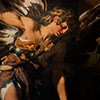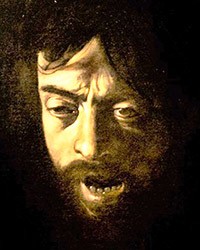Giovanni Baglioni’s Heavenly Love and Earthly Love – a virtue in the struggle against sin
These outstanding collectors included such people as Scipione Borghese, Ciriaco Mattei, Francesco Maria del Monte, Ottavio Costa, Pietro Aldobrandini, Paolo Emilio Sfondrati, but also the brothers Giustiniani. One of them, the Marquis Vincenzo Giustiniani, an outstanding patron of the arts, with a refined taste, bought the canvas of all noteworthy artists active in the city on the Tiber. However, he showered the highest praise upon Annibale Carracci and Caravaggio. It was also for him that, Michelangelo Merisi, since that was the true name of Caravaggio, painted the work entitled Amor Victorious (1602), which caused a great commotion among both art collectors and artists themselves. Giustiniani valued this composition very highly and put it in an appropriate location in his palace.
Love and desire are not to be resisted – that is what Caravaggio seems to be saying in his work as if paraphrasing the words of Virgil "Love conquers all things, so we too shall yield to love”. The bold pose of the youthful Amor, his laughter, and shameless gaze definitely stimulated discussions on the power of love which destroyed human life – his virtues and values, scorning all actions and ambitions. The proof of the devastating power of this feeling can be seen at the feet of Amor, in the shape of the scattered musical instruments, musical scores, armor, diadem, laurel leaves, books, and measuring tools (compass and square). Undoubtedly this painting also included a homoerotic overtone, and the demonic evil and sinful love connected with it.

Amor Victorious immediately became a challenge for painters, who desired to compete against Caravaggio. One of these was an artist, who is completely forgotten today, but one that was highly valued at the beginning of the XVII century – Giovanni Baglione. He was not only an artist but also a chronicler of contemporary artist life. The observations he made about his colleagues were put in a book published in 1642. In it, he talks about Caravaggio's boastfulness, his conceit, but also about the renown that the Lombard enjoyed among the Roman elites. He also devotes a paragraph to his Amor calling it “a demon in the guise of a man”. The relations between Baglione and Caravaggio were defined by a type of artistic rivalry, but also plain animosity. After the great success achieved by the paintings in the Contarelli Chapel in the Church of San Luigi dei Francesi, their author Michelangelo Merisi achieved fame and renown among art collectors. His way of painting with the use of strong chiaroscuro, thanks to which the figures in his canvas emerge out of darkness, creating dramatic actions and naturalism gained him the admiration of many artists (who at the displeasure of Caravaggio himself) began to imitate his style. Among these was Baglione, who had several times, used the fashionable tenebrism of his rival. He also did this in 1602 when he completed two nearly identical paintings and dedicated them to the brother of Vincenzo Giustiniani – another significant art collector, Cardinal Benedetto Giustiniani. This was to be not only a polemic with the disliked Caravaggio but also an ideological declaration straight into the hands of a high-ranking Church official.

Baglione's paintings had in the past hung in one of the rooms of the Palazzo Giustiniani, however, today one of them is found in Berlin ((Gemäldegalerie), the other in Palazzo Barberini in Rome. The main protagonist of both versions is the standing heavenly Amor, punishing the prone, fearful earthly Amor. On the left we can see yet another figure – a sitting demon, emerging from the darkness. The heavenly Amor stands between them as if he wanted to break apart this sensual act. Dressed in armor (in the Berlin painting) he is firing an arrow in the direction of the earthly Amor, destroying his arrows, and trampling the shackles of the demon, whose face remains unseen. In the Roman painting, Baglione repeats this motif, however, the heavenly Amor is dressed in a fancy dress, reminiscent of Greek gods, and also fires an arrow in the direction of the earthly Amor, trampling the arrows, but the demon directs his gaze towards us – and at this moment we can see his mouth open agape with fear, large eyes, and pointed ears. Baglione’s’ paintings were a clear declaration of the superiority of the love of God, over the sinful earthly love and its demonic visage, and it would seem that this sinfulness concerned homosexual love. In the celestial Amor, we can see the figure of a Guardian Angel – an intermediary between man and God saving people from evil and deprivation.

Caravaggio, who did not value Baglione as a painter, immediately criticized his canvas, especially since he saw himself in the face of the demon. Both he and his wont to ridicule others friends officially laughed at the armor of the heavenly Amor and the lack of balance between both allegories – the enormous heavenly Amor and the tiny earthly Amor. Cardinal Giustiniani had a different opinion and gifted the author of the paintings with a gold chain, which was the expression of the highest approval of his talent and the works he had created. It should come as no surprise, as the motif of the fall of the earthly Amor (earthly love) in the struggle against the powers of heaven, was part of the official teachings of the Church and Baglione’s compositions fit perfectly with it.

The success enjoyed by the paintings was a bitter pill to swallow for Caravaggio’s group, especially at a moment when Baglione obtained another significant commission, this time from the Jesuits who entrusted him with the decoration of the main altar of the Church of Il Gesù. There were numerous satirical poems slandering Baglione. In vulgar terms, they accused him of a lack of talent, and incompetence, and mentioned the golden chain, which he was utterly undeserving of, as well as the “rubbish", that he began creating for the Jesuits. These calumnies led to Baglione suing his adversaries (Orazio Gentileschi, Ottavio Leoni, Onorio Longhi, Caravaggio), in 1603, accusing them of jealousy due to the success that he had achieved. During the trial, Caravaggio was able to express his dislike for Baglione and the disapproval of his art, which was meticulously noted by the court reporter, allowing us to get to know the views of Caravaggio and his colleagues about painting. The trial was a kind of a conflict between official "mainstream" painters gathered around the Accademia San Luca and "freelancers", who were becoming more and more valued by art collectors. They were well-paid but did not enjoy the admiration of the “academicians” who were jealous of their fame. This group included Baglione, who was convinced of the superiority of his art, which was above the pure imitation of reality (attributed to Caravaggio).
The paths of both painters would continue to cross for the next several years in Rome until Caravaggio's escape from the city in 1606. Baglione would remain in Rome for many decades and would be swamped with subsequent commissions, in which he will distance himself further and further from Caravaggio's style. He would only be forgotten a few centuries later, at least as a painter.
Amor sacro e Amor profano, Giovanni Baglione, 1602–1603, oil on canvas, 240 x 143 cm, Palazzo Barberini, Galleria Nazionale d'Arte Antica, Rzym
Amor sacro e Amor profano, Giovanni Baglione, 1602, oil on canvas, 183 x 121 cm, Gemäldegalerie, Staatliche Museen, Berlin (in armor)
If you liked this article, you can help us continue to work by supporting the roma-nonpertutti portal concrete — by sharing newsletters and donating even small amounts. They will help us in our further work.
You can make one-time deposits to your account:
Barbara Kokoska
BIGBPLPW 62 1160 2202 0000 0002 3744 2108
or support on a regular basis with Patonite.pl (lower left corner)
Know that we appreciate it very much and thank You !






























